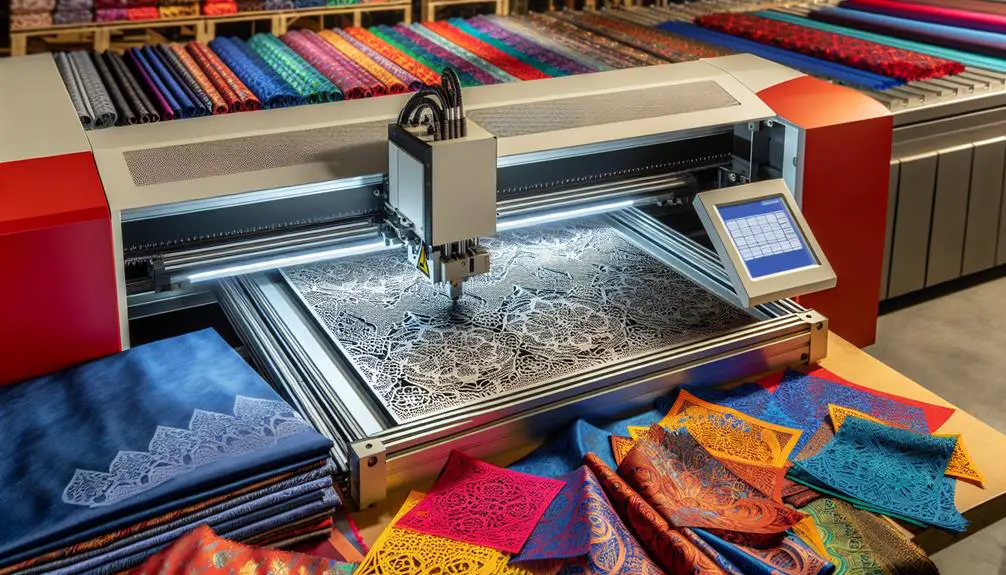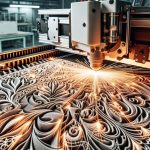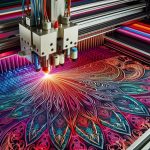Laser cutting fabrics lets you achieve unparalleled precision and intricate designs quickly. It's ideal for detailed patterns and minimizing waste. You can cut various materials like cotton, linen, polyester, nylon, felt, and silk. Using a CO2 laser cutter is common due to its accuracy and efficiency. Confirm your fabric is clean and smooth before cutting, and secure it well to avoid movement. Adjust settings based on your material's thickness and texture. Don't forget to test on scraps and keep your machine maintained. Stick around to master every step and make the most of laser cutting for fabrics.
Table of Contents
Key Takeaways
- Laser cutting offers precise and intricate designs, perfect for detailed patterns and complex shapes.
- Cotton, linen, polyester, nylon, felt, and silk are suitable fabrics for laser cutting, considering their thickness and texture.
- CO2 lasers are ideal for fabric cutting due to their precision and compatibility with various materials.
- Clean and iron fabric, secure it on the laser bed, and test small samples to adjust settings before cutting.
- Maintain your laser cutter by cleaning optics, checking the cooling system, and following manufacturer guidelines for optimal performance.
Benefits of Laser Cutting
Laser cutting offers precise and intricate designs that are tough to achieve with traditional fabric cutting methods. If you're aiming for mastery in fabric design, you'll love how laser cutting provides unparalleled precision cutting. This method uses a focused laser beam to slice through fabric with exacting accuracy, making it perfect for detailed patterns and complex shapes.
One of the standout benefits is cost efficiency. Traditional methods often require multiple tools and manual labor, leading to higher costs and potential errors. With laser cutting, you can reduce waste and minimize mistakes, ultimately saving money.
Design versatility is another huge advantage. Whether you're working on delicate lace or sturdy denim, laser cutting adapts effortlessly to different materials and designs. The flexibility allows you to switch between various styles without needing new equipment or extensive setup changes.
Suitable Fabric Types
You'll find that several types of fabrics are particularly well-suited for laser cutting. When selecting a fabric, consider both fabric thickness and fabric texture to achieve the best results. Natural fabrics like cotton and linen are excellent choices due to their smooth texture and moderate thickness, which allow for precise cuts and minimal fraying. Synthetics such as polyester and nylon also work well because they melt slightly at the edges, sealing the cut and preventing fraying.
Here's a quick reference table to help you understand which fabrics are ideal for laser cutting:
| Fabric Type | Characteristics |
|---|---|
| Cotton | Smooth texture, moderate thickness |
| Linen | Smooth texture, moderate thickness |
| Polyester | Synthetic, melts to seal edges |
| Nylon | Synthetic, melts to seal edges |
| Felt | Thick, non-woven, minimal fraying |
| Silk | Thin, delicate texture, requires precision |
Felt is another great option due to its thickness and non-woven texture, which results in clean, fray-free cuts. Silk, while more delicate, can be laser cut with precision, making it perfect for intricate designs. By understanding the fabric thickness and texture, you can master the art of laser cutting fabrics and achieve professional results every time.
Choosing the Right Laser Cutter
When choosing a laser cutter for fabric, it's essential to evaluate the different types available and consider their features. Material compatibility, power levels, and precision are key factors to look into. This evaluation process will help you identify a machine that aligns with your specific requirements.
Laser Cutter Types
Choosing the right laser cutter for fabric involves considering factors like power, precision, and material compatibility. When it comes to laser cutter power, you'll want to focus on machines that have enough wattage to easily slice through the types of fabrics you're working with. For most textiles, a 40-60 watt laser is usually adequate, but if you're dealing with thicker materials, you might need something more potent.
Cutting speed is another vital factor. High cutting speed can greatly enhance your productivity, especially if you're working on large projects or have a tight deadline. Look for laser cutters that offer adjustable speeds so you can fine-tune the machine based on the fabric type and desired finish.
There are primarily three types of laser cutters you can consider: CO2 lasers, fiber lasers, and diode lasers. CO2 lasers are the most popular for fabric cutting due to their ability to handle a wide range of materials with high precision. Fiber lasers, while typically used for metals, can also cut synthetic fabrics efficiently. Diode lasers are less common but can be a good option for specific, smaller applications. Choose the type that best aligns with your needs and project scope.
Essential Features Overview
To secure the perfect laser cutter for your fabric projects, pay attention to vital features like wattage, cutting speed, and material compatibility. High wattage translates to better cutting precision, especially for thicker fabrics.
Aim for a laser cutter that offers adjustable speed settings, allowing you to fine-tune for various fabric types and cutting techniques.
Another essential feature is the compatibility with different materials. Make sure the cutter can handle everything you plan to work with, from delicate silks to durable denim. Versatility in material compatibility will save you from needing multiple machines.
Safety precautions are non-negotiable. Look for models equipped with necessary safety features such as automatic shut-off and protective enclosures. These guidelines assure you can focus on your craft without worrying about potential hazards.
Ease of use is another factor to contemplate. Opt for a laser cutter with an intuitive interface and user-friendly software. This will make it easier to execute complex designs and cutting techniques, ensuring your projects are both efficient and precise.
Preparing Your Fabric
Before you start cutting, select the appropriate materials for laser cutting.
Take care of your fabric by cleaning and ironing it to guarantee smooth cuts.
Secure your fabric properly on the laser bed to prevent any movement during the process.
Choosing Suitable Materials
When preparing your fabric for laser cutting, knowing which materials are suitable is essential to guarantee clean and precise cuts. Fabric compatibility is key. Natural fibers like cotton, linen, and silk cut well and don't emit harmful fumes. Synthetic fabrics such as polyester and nylon are also compatible, but be cautious of the melting point to avoid burns. Using advanced techniques can help you determine the best settings for each type of fabric.
Textile innovations have introduced materials specially designed for laser cutting. These fabrics often have coatings or treatments that improve the cutting process, ensuring smoother edges and reducing fraying. Exploring alternative methods, such as laser-friendly blends or engineered textiles, can enhance your results.
To master the art of laser cutting fabrics, you'll need to experiment with different materials. Test small samples first to adjust settings and find the sweet spot for each type. Pay attention to the fabric's thickness and weave, as these factors can affect the accuracy of your cuts.
Pre-Cutting Fabric Care
Taking proper care of your fabric before cutting is important for achieving the best results with your laser cutter. Start by focusing on fabric handling and storage.
Always store your fabrics in a clean, dry area to prevent dust, moisture, and wrinkles. Roll or fold your fabric neatly to avoid creases that could impact the cutting process.
Before cutting, fabric pre-treatment is vital. Begin by cleaning your fabric. Wash and dry it according to the manufacturer's instructions. This not only removes any residues that might interfere with the laser but also pre-shrinks the fabric, guaranteeing more accurate cuts.
After washing, iron your fabric to remove any wrinkles. A smooth, flat fabric is much easier to work with and guarantees cleaner cuts.
When handling fabric, always use clean hands or gloves to avoid transferring oils or dirt. If your fabric has a nap or pattern, make sure to align it correctly before cutting.
Proper fabric handling and storage, combined with thorough pre-treatment and cleaning, will set you up for success with your laser cutting projects. Invest this time upfront, and you'll achieve precise, professional results every time.
Securing Fabric Properly
Securing your fabric properly is vital to achieving clean, accurate cuts with your laser cutter. Proper preparation guarantees that your fabric stays in place and doesn't shift during the cutting process, which is essential for maintaining cutting accuracy and fabric alignment.
Here's how you can master this step:
- Smooth the Fabric: Lay your fabric flat on the cutting bed and smooth out any wrinkles or folds. Wrinkles can interfere with the laser's path, resulting in uneven or inaccurate cuts.
- Use Weights or Clamps: To maintain fabric tension and prevent shifting, use weights or clamps. This added stability helps keep your fabric aligned and guarantees your cuts are precise.
- Check Fabric Alignment: Make sure your fabric is aligned with the machine's grid or guides. Proper alignment is vital for cutting accuracy, ensuring that your design is perfectly positioned on the fabric.
- Adjust Laser Settings: Before starting the cutting process, adjust your laser cutter's settings according to the fabric type and thickness. Proper settings will help you achieve clean cuts without burning or fraying the fabric.
Setting Up Your Machine
To get started with laser cutting fabrics, make sure your machine is properly calibrated and all necessary safety precautions are in place. Begin by checking that your workspace is well-ventilated and you have suitable protective gear, such as safety glasses and gloves. Ensuring your machine calibration is spot-on is essential for achieving precise cuts. Follow your manufacturer's guidelines to fine-tune the laser settings and test on scrap material if needed.
Next, you'll need to focus on software setup. Open your design software and import the pattern you plan to cut. Adjust the settings to match the type of fabric you're using, such as the power, speed, and frequency of the laser. Most software programs offer presets for common materials, but you can always customize these settings for best performance.
Once your software is configured, it's time to align your material. Place the fabric on the laser bed, making sure it lies flat and wrinkle-free. Use clamps or weights to secure it in place if your machine doesn't have a vacuum table. Double-check the alignment to ensure the laser will follow the intended path accurately.
With everything set, you're now ready to start cutting!
Best Practices for Cutting
For the best outcomes when laser cutting fabrics, make certain your material is clean and free of any debris. This promotes cutting precision and reduces the chance of fabric fraying.
Here are some best practices to follow:
- Maximize Cutting Speed: Adjust your laser's speed settings based on the fabric type. Quicker speeds can help minimize waste but may reduce cutting precision. Experiment to find the ideal point where you achieve clean cuts without excessive fraying.
- Use the Appropriate Settings: Different fabrics necessitate different laser settings. Fine-tune the power and speed for each material to get the finest results. Lower power settings combined with higher speeds often yield the cleanest cuts for delicate fabrics, preventing fraying.
- Test on Scraps: Always test your settings on a small piece of the same fabric before cutting your main project. This helps you adjust the laser settings to achieve the finest results, minimizing waste and ensuring high precision.
- Secure the Fabric: Guarantee the fabric is flat and taut on the cutting bed. Use weights or adhesive spray if necessary. This prevents movement during cutting, which can lead to misalignment and waste.
Troubleshooting Common Issues
Even with the best practices in place, you might still encounter some issues while laser cutting fabrics. Don't worry, though; most common problems have straightforward solutions.
One frequent issue is fraying edges. This can often be resolved by adjusting the laser power or speed settings. Sometimes, a quick fix involves using a different type of fabric stabilizer.
Another common problem is fabric scorching. If you notice burn marks, try lowering the laser's power or increasing its speed. You could also test on scrap material to fine-tune your settings.
Misaligned cuts are another headache; make sure your fabric is securely fastened and the laser bed is properly calibrated.
Inconsistent cutting depth can be annoying, but it's usually due to uneven fabric thickness. Double-check your material and, if needed, adjust your focus or use a different cutting mat.
Lastly, if your fabric moves during cutting, consider using a vacuum table or applying a temporary adhesive.
This troubleshooting guide is designed to help you quickly identify and solve these issues. By mastering these troubleshooting techniques, you'll achieve smoother operations and higher-quality results in your laser cutting projects.
Maintaining Your Laser Cutter
Regular maintenance of your laser cutter guarantees peak performance and extends its lifespan. By keeping your machine in top shape, you'll avoid costly repairs and guarantee precise cuts every time.
Here are some essential cleaning maintenance and troubleshooting tips to follow:
- Clean the Optics: Keep the lenses and mirrors spotless. Dust and residue can reduce the laser's effectiveness. Use a lens cleaning solution and a soft cloth to gently clean the optics. Regularly check for any scratches or damage.
- Check the Cooling System: The cooling system prevents overheating. Make sure that the water level in the chiller is sufficient and that there are no leaks. Clean the filters frequently to maintain proper airflow and cooling efficiency.
- Lubricate Moving Parts: Keep the guide rails, belts, and other moving parts well-lubricated. Use the manufacturer-recommended lubricant and follow their guidelines for application frequency. This reduces wear and tear and guarantees smooth operation.
- Inspect Electrical Connections: Over time, vibrations can loosen electrical connections. Regularly inspect all connections to guarantee they're tight and secure. Look for signs of wear or fraying in the wiring and replace any damaged components.
Frequently Asked Questions
Are There Any Health Risks Associated With Laser Cutting Fabrics?
Yes, there are potential hazards when laser cutting fabrics. You should guarantee proper ventilation requirements to avoid inhaling harmful fumes. Always use protective gear and maintain a well-ventilated workspace to minimize health risks.
How Does Laser Cutting Affect the Durability of the Fabric?
Laser cutting generally preserves fabric strength, enhancing precision without fraying. For longevity assessment, the process doesn't compromise durability notably, ensuring your projects maintain their integrity over time. You'll find it a reliable method for quality results.
What Safety Gear Is Recommended When Operating a Laser Cutter?
Why risk injury? Always follow safety precautions and wear the right equipment like safety goggles and gloves. Stick to proper operating procedures, and make sure you've undergone training. Safety first, so you can master laser cutting confidently!
Can Laser Cutting Be Used for Both Natural and Synthetic Fabrics?
Yes, you can use laser cutting for both natural and synthetic fabrics. It offers versatile fabric applications and minimizes environmental impact by reducing waste. It's a great choice for eco-conscious creators looking for precision and efficiency.
How Do Different Fabric Colors Affect the Laser Cutting Process?
Just like in "The Matrix," fabric color can alter your reality. Darker colors absorb more laser energy, impacting cutting accuracy. Adjust your laser settings to account for the color impact, ensuring precise cuts regardless of hue.
- How Does Ring Spun Cotton Affect Garment Fit and Shape Retention? - August 13, 2024
- What Are the Challenges in Producing Ring Spun Cotton? - August 13, 2024
- Is Ring Spun Cotton Suitable for Plus-Size Clothing? - August 13, 2024







